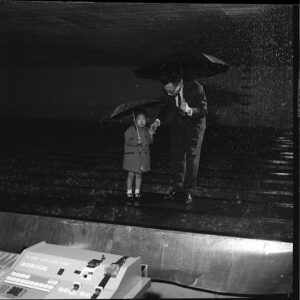Ven Te Chow came to campus like a storm. After graduating from National Chiao Tung University in China in 1940, he earned a master’s degree from Pennsylvania State in 1948. That year he came to the University of Illinois Urbana-Champaign where he began working towards his Ph.D. While Chow’s background was in civil and mechanical engineering his attention shifted toward hydrologic engineering, that is engineering with a focus on water resources.
Right from the start, Chow began researching storm drainage and helped design the storm drainage system for Chicago’s Congress Expressway (now known as the Eisenhower Expressway). He continued to work on storm drainage in Chicago and around the world throughout his career. He developed the frequency factor to help optimize storm drainage and it was quickly adopted nationally and internationally.
Chow’s most spectacular innovation was the creation of an indoor storm simulator. This allowed researchers to simulate storms using a complex system of sonar, electricity and pneumatic controls, like those that take checks at a bank. The room had 23,000 openings in the ceiling capable of releasing water to form individual droplets. Afterwards, a computer analyzed the storm and would produce results in a matter of minutes. He simulated different types of rain storms and terrain which allowed for more controlled experimentation.

In part by using this “storm room” he made breakthroughs in the analysis of water drainage, predictive hydrology, and water resources management. For example, the water that was drained from the “storm room” was collected and measured to help study how storm water drained.
While conducting this innovative research he was still able to publish very frequently. These included everything from highly technical publications about his innovations to a widely used Handbook of Applied Hydrology.
Another innovation by Chow was being a founder of the International Water Resources Association. Serving as its first president, he helped establish the organization as a reputable organization that has gone on to be quite influential to scientists studying hydrological sciences. He also served as a guest lecturer for other organizations across the world including in Turkey, India, Mexico and Serbia. Due to his impact across the globe he received dozens of awards and is often seen as a great amongst fellow hydrologists
- Civil Engineering Hydrosystems Laboratory – This is the building where Chow built his famous “rainmaker”
- Boneyard Creek – Chow often advocated for the continued operation of the low discharge gauging station. The data from the creek also helped to develop solutions to regular flooding problems. You can find a plaque explaining more at Boneyard Creek.
[endcollape-pane]
Ackermann, W.C. (1984). Ven Te Chow 1919-1981. In National Academy of Engineering (Ed), Memorial Tributes, Vol 2. The National Academies Press. (pp. 47-52). https://doi.org/10.17226/565
Bierkens, M.F.P. & van Geer, F.C. (2008). Stochastic Hydrology. http://www.earthsurfacehydrology.nl/wp-content/uploads/2012/01/Syllabus_Stochastic-Hydrology.pdf
Garcia, M.H. (2017). Ven Te Chow: Hydrologist, Educator and Rainmaker. In F. Hoxie University of Illinois: Engine of Innovation (pp. ). University of Illinois Press.
LIFE (1969, June 6). Room with a Built-in Deluge. LIFE Magazine. 77-78. https://books.google.com/books?id=bU8EAAAAMBAJ&pg=PA77&source=gbs_toc_r&cad=2#v=onepage&q&f=false
Peterson, D. (2020, September 7). Ingenious: The Rainmaker. University of Illinois Alumni Association. https://uiaa.org/2020/09/07/ingenious-the-rainmaker/
Ven Te Chow in Rainmaker with Child. (1960). Photographic Subject File, Record Series 39/2/20, Box FAC-4 C-D. University of Illinois Archives.
Contributors: Render Symanski
